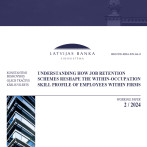The rate of annual increase of average wage remains high in the third quarter
The latest data indicate that the monthly average wage continues to increase. The growth of productivity next year is expected to be slower and the rise in wages will also be more moderate in 2015.
According to the Central Statistical Bureau (CSB), the gross monthly average wage in the third quarter of 2014 rose by 7.4% year-on-year. The net rise was slightly higher at 8.7%, which can be explained by favourable changes in taxation legislation: lowering the social insurance payment rate and raising the untaxed minimum and remission for dependents as of 1 January 2014.
Currently, the annual rise in wages is relatively fast, yet it mostly reflects the positive development of the economy in the previous years when enterprises posted high profitability indicators, which in turn allowed wages to be raised.
In 2015, wages are expected to continue to rise, yet slightly more moderately than this year. The growth of gross domestic product and thus also productivity is expected to be slower in 2015 than in previous years that will reduce the fundamental basis for salary rises. At the same time, from the perspective of labour demand, the evaluation of lack of labour by entrepreneurs (data of survey by the European Commission) remains moderate, which in the future as well will not allow salaries to depart from productivity, thus not giving rise for risks of imbalance in the economy.
The impact of the changes in the legal environment on the average wage in 2015 will be favourable, albeit less so than in 2014. The rises in minimum wage (which influences both gross and net salary) are the same in both years (12.5%). It can be estimated that an additional impact on net salary from the population income tax (PIN) rate reduction by 1 percentage point (as of 2015) will be less than from the rise of the untaxed minimum and the reduction of the rate of mandatory payments of state social insurance for employees (as of 2014).
So far, the rise in average salary has not been reflected to any substantial degree in other macroeconomic indicators. For instance, the rise in private consumption is still substantially weaker than the real rise in wages (real net rise in wages in the third quarter of 2014, taking into account the rises in consumer prices, was 7.8%; the rise in private consumption was 2.1%), which may indicate a possible formation of household accruals. As a result of the above reason, the rise in wages has so far been reflected in inflation of consumer prices only in a limited way.
Textual error
«… …»




